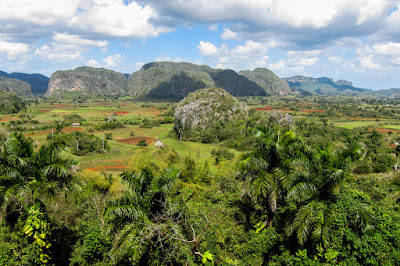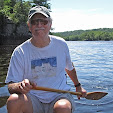THE TWO-BIT TOUR
That whole day the mosquitoes had been out in force. Not remembering which kind—the day-biters or night-biters—are most apt to spread dengue and chikungunya, I tried to seal the night ones out of my room before I went to bed. But, with good inch-wide gaps under the doors and a pinky's width between the louvers of the blinds on the screen-less windows, I gave up and just applied repellent to my head, shoulders and arms.
The next morning, after a wonderful breakfast of fresh papaya, pineapple and banana, scrambled eggs, bread and a robust cafe criollo, I headed downtown to find my own fun for the day. A young man was aggressively pitching bike rentals, but I opted for an excursion by taxi. My driver, a pleasant veteran taxista named René, took me first up to the Mirador, or overlook, at Hotel Los Jazmines, which affords a sweeping bird’s-eye vista of the lush terrain around Viñales.
 |
| PHOTO: NeverEndingVoyage.com |
Then it was on to the Mural de la Prehistoria, which I’d assumed would be something like the ancient Native American petroglyphs found on some cliffs in Minnesota. Instead, it is a contemporary, massive, 60-meter-high cliff painting simply depicting, in gaudy colors, some prehistoric themes. Reputedly, it was commissioned by Fidel Castro himself.
 The last stop on my little taxi tour was at the Cueva del Indio, a cavern running all the way through the base of one of the mogotes, or limestone massifs, which served as a refuge for runaway slaves during the late 18th and early 19th centuries. Though the little re-enactment of slave life and culture lacked showmanship, the natural beauty of the rock formations and the flora and fauna behind the mogote all but made up for it.
The last stop on my little taxi tour was at the Cueva del Indio, a cavern running all the way through the base of one of the mogotes, or limestone massifs, which served as a refuge for runaway slaves during the late 18th and early 19th centuries. Though the little re-enactment of slave life and culture lacked showmanship, the natural beauty of the rock formations and the flora and fauna behind the mogote all but made up for it.RUM-INDUCED SPANISH
That afternoon, I walked into town and bought a few souvenirs and gifts for folks back home—rum, cigars and several handsome little “secret boxes” of inlaid woods forming the pattern of the Cuban flag (secret in that the little drawer slides out only if one can figure out the obscure trick of where to grasp it).
At a small restaurant I enjoyed a bowl of seafood soup, served with fried malanga chips. (Malanga is a starchy tuber, closely related to taro, that makes for chips every bit as tasty as potato chips.) And speaking of comparisons, my TuKola—Cuba’s best effort at a stand-in for American-made Coke—tasted nearly identical to the iconic brand.
I kept up with his Cuban Spanish quite well—
better and better, in fact, as we polished off
the rest of my bottle of rum.
Waiting for me back at the casa were some familiar faces. Four fellow students in the Jakera-Havana program—all lovely young women from various parts of Europe—had decided to join me for a brief overnight taste of Viñales. They were staying at a casa a half block down the street.
That night my fellow guests at Zoila and Maruco's casa, Luut and Joyce, joined me for a wonderful roast pork dinner on the patio. After dessert, they left for a night of music and dancing downtown, and Maruco came out and joined me for a drink, which turned into several.
(This was one of those moments I live for in my Spanish-learning quest—just chatting at length with one of the locals about everything from gardening to politics, business to sports. Cutting through Maruco’s Cuban pronunciation, with its unique rhythm and dropped consonants, was good practice for my listening skills, and I found myself keeping up with him quite well—better and better, in fact, as we polished off the rest of my bottle of rum.)
CLIMBING FOR COFFEE
 Sunday morning, I was up at 5:00 for a horse-cart ride, along with my four young compañeras, up into the hills to catch the sunrise. Packed like sardines into the rickety cart, off we went enveloped in darkness broken only by a faint glow on the eastern horizon and our driver's faltering flashlight. Something about the cool, misty air and the clip-clop of the horse’s hooves on the pavement brought home the sheer beauty and magic of this enchanting place. I knew this would be another Cuba moment I’d never forget.
Sunday morning, I was up at 5:00 for a horse-cart ride, along with my four young compañeras, up into the hills to catch the sunrise. Packed like sardines into the rickety cart, off we went enveloped in darkness broken only by a faint glow on the eastern horizon and our driver's faltering flashlight. Something about the cool, misty air and the clip-clop of the horse’s hooves on the pavement brought home the sheer beauty and magic of this enchanting place. I knew this would be another Cuba moment I’d never forget.We turned off the highway onto a rough, narrow dirt road—all of us now clutching the sides of the cart for dear life as it bucked and rolled through six-inch-deep puddles and potholes. After a couple of miles, the road deteriorated into little more than a deep, mud-filled trench which turned out to be impassable for our cart. So our driver tied up his horse and we continued climbing on foot, our six little flashlight beams strung in single file along the raised edges of the muddy track.
As sunlight erupted from the very crown of the
highest peak, they served us each a cafecito,
a small, concentrated, absolutely amazing little
cup of their own coffee.
Besides just watching our step over muddy rocks and though knee-high wet grass, our biggest challenge was crossing a creek on a bridge consisting of a slippery 50-foot log with nothing but a single waist-high cable to hold onto…in the dark.
At the first hints of daylight we finally reached our destination, a small coffee finca, or farm, perched on the flank of the mountain. Looking out over the area we’d just climbed, we could soon make out the different features of the landscape—fields, tobacco barns, a couple of roads, and, of course, the magnificent mogotes, now starkly silhouetted by the sun rising just behind them.
 The young couple who own the operation greeted us and explained the process of growing, harvesting, drying and roasting their fragrant product. Then, just as sunlight erupted from the very crown of the highest peak, they served us each a cafecito, a small, concentrated, absolutely amazing little cup of their own coffee, along with some cookies and chunks of fresh coconut.
The young couple who own the operation greeted us and explained the process of growing, harvesting, drying and roasting their fragrant product. Then, just as sunlight erupted from the very crown of the highest peak, they served us each a cafecito, a small, concentrated, absolutely amazing little cup of their own coffee, along with some cookies and chunks of fresh coconut. As we soaked it all in, we were beset by some aggressive little biting flies. Very much like a larger, more venomous version of a menace we in Minnesota call black flies, they left us polka-dotted with half-inch red welts with bloody centers.
BACK-TO-HAVANA BLUES
I dreaded my return to my over-structured classes and the claustrophobic street-canyons of Old Havana that afternoon, but all good things must end. I packed up my gear and bid a fond farewell to Maruco, Zoila and Dyan. Not wanting to wait for the late bus, my compañeras and I, along with another young man we hadn't met, packed into a funky taxi—an old, green Pontiac station wagon—and hit the road.
 The "green monster's" seats were lumpy and I was pressed against a door whose jury-rigged latch I didn't trust. And then there were the windows—or should I say the lack of windows. Alas, just as we hit Havana's suburbs it started to pour, and those of us in window seats crammed in toward the middle trying, unsuccessfully, not to get drenched.
The "green monster's" seats were lumpy and I was pressed against a door whose jury-rigged latch I didn't trust. And then there were the windows—or should I say the lack of windows. Alas, just as we hit Havana's suburbs it started to pour, and those of us in window seats crammed in toward the middle trying, unsuccessfully, not to get drenched. Wet and cold as I was, it was far from enough to dampen the lingering glow of my brief excursion to Viñales, that friendly, stunningly beautiful little corner of northwestern Cuba.














































